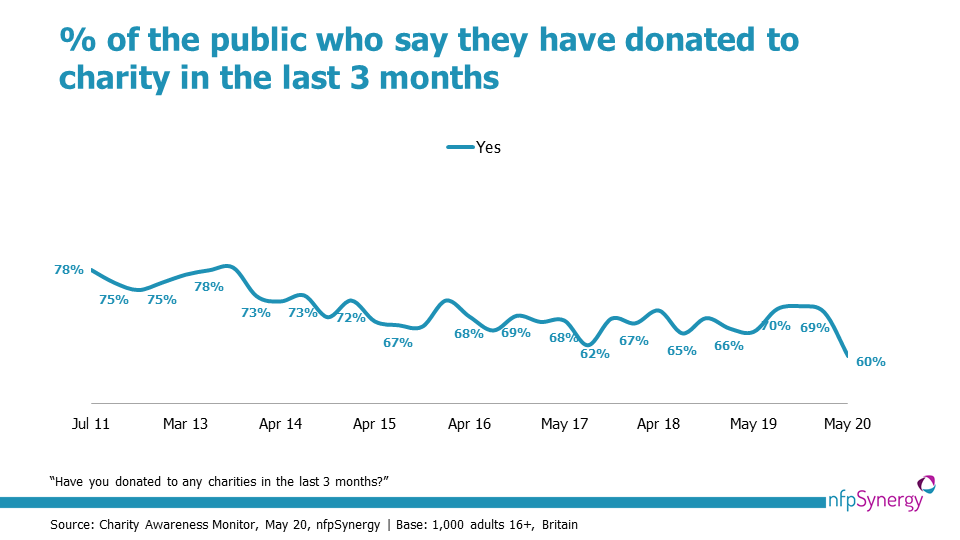nfpSynergy has been monitoring giving levels every quarter for well over a decade. Our research is one of the longest, robust and regular records of giving patterns in the UK with over 50 separate polls. This latest quarter we saw some dramatic changes as a result of the coronavirus pandemic. Here are some of the highlights.
The bad news is:
- Number giving down to lowest level in a decade – only 60% of the public say they’ve given to charity in the last 3 months, down from 69% in January this year
- Charity shops and on-street collections have posted the biggest drops in giving
The good news is:
- Conversely, giving on a charity website and via text message are at their highest levels since we started tracking this question
- The public say they are almost twice as likely to cut back on eating out than donating to charity
- Over 65s are the least likely to say they will cut back on their charitable spending – a promising sign for fundraising
- The average amount given over the last 3 months has risen to £67.70, suggesting that whilst the overall number of donors has declined, those who continue to give, are giving generously
The biggest quarterly fall in percentage giving in over ten years
The coronavirus (COVID-19) has had a significant impact on the proportion of the public saying they have donated to charity in the last 3 months. In late May, only 60% of the public said they had donated to charity, down from 69% in January this year. 60% is the lowest overall level since we started asking this question in 2011.
This fall will confirm what many charities expected and feared, and comes at a time when fundraising was already on a downward trend. This year’s Charity Financials Spotlight report showed that public fundraising for the top 100 charities fell 2.9% in 2018/19, and the trend was already heading in a downward direction before the pandemic struck. I dread to think what the figures for 2020/21 will look like when they come out in a couple years.


Giving methods reflect the impact of the lockdown
If we dig into the data a little more, we see that face to face methods of donation are down significantly, in particular buying from and donating to charity shops, and giving to on street cash collections. On the flip side, giving through charity websites and via text message are at their highest level since we started tracking this question.
Our COVID-19 polling in recent weeks has shown that the public are very receptive to the idea of giving to charity at this time. In our polling, 60% of the public said they would be willing to support a charity responding to coronavirus and 68% said they think charities should continue to fundraise during the pandemic. However, the much lower proportion of the public who say they are donating reflects the fact that giving is about asking. If less people are being asked fewer opportunities the public has to give; charity shops aren’t open, fundraising events have been cancelled and street fundraising has stopped.
There are however some causes for optimism
Only 38% of the public say they plan to cut back on their charitable spending in the next 12 months. Whilst this doesn’t sound great, this is a lot lower than many other areas of spending, such as 68% saying they’ll cut back on eating out, 64% who say they’ll cut back on holidays and 62% who say they’ll cut back on large purchases. Even more promising, only 22% of those aged over 65, a key fundraising audience, say they will cut back on their charitable spending in the next 12 months.
Also, the average amount donated to charity in the last 3 months has increased from around £50 in January to £67.70 in May. This suggests that whilst the overall number of donors has decreased, those who have remained are the higher value, more loyal donors. A note of caution though: we need to be careful about the gap between the public saying they would, or are, giving and what they actually do.
It’s about the economy stupid
With last week’s news that the economy shrunk by a fifth in April, it is clear the country is in for a tough time. But beyond the lockdown’s immediate impact on charities’ ability to raise funds, it is not necessarily clear what the long-term impact will be of a recession on the sector.
Many charities saw their incomes rise through the last financial crisis. In Ireland (where the recession was deeper and more damaging than in Britain), many charities actually saw their high water-mark in terms of fundraised income in 2011 at the height of the crisis, perhaps owing to the stark evidence of the need for charities’ services.
While huge numbers of people will doubtlessly be affected by the coming economic crisis, older charity donors are more likely to be retired on fixed incomes (and may therefore be somewhat insulated). Our data suggests there are grounds for both deep pessimism, and for cautious optimism that the public are not yet predicting a catastrophic decline in their charitable giving in the future. Time will tell which the actual outcome is.

